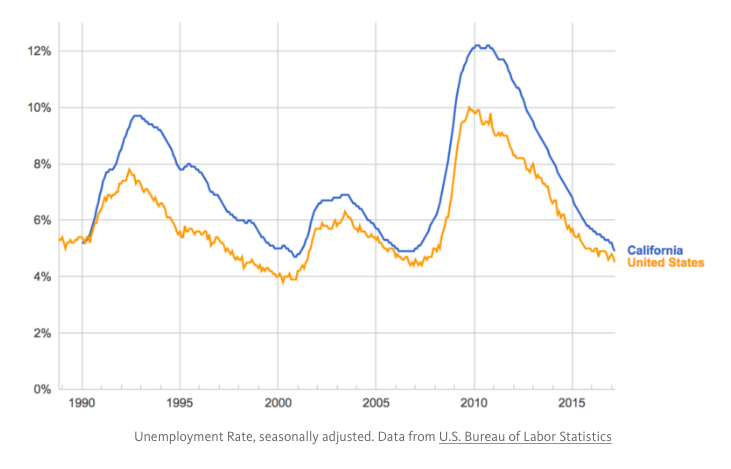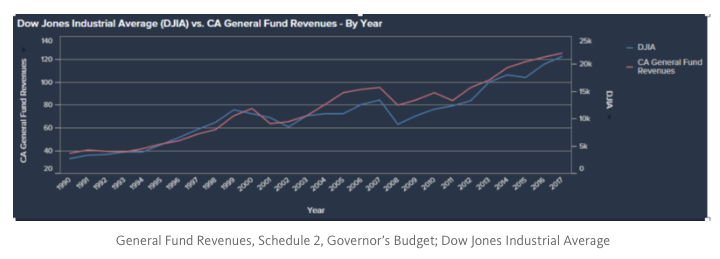California’s economy rises and falls with the national economy:

Governors have little to do with those waves but their approval ratings ride right alongside. Pete Wilson wasn’t touted as presidential material until the economy improved in the 1990’s. Gray Davis rode the dot-com boom to high approval ratings until the 2001 dot-com crash. As housing roared until the 2008 crash, some suggested amending the US Constitution so Arnold Schwarzenegger could run for president. A vibrant economy has Jerry Brown talking about running for president again.
California’s governors always look good when the economy looks good but, to quote Warren Buffett, you only find out who has been swimming naked when the tide goes out. California’s next governor is likely to swim in some very shallow water because of economic cycles and three other ingredients.
Because the current economic recovery is already 60 percent longer than the average post-WWII recovery, California’s next governor, who will take office in January 2019, is highly likely to be presented with an economic downturn at some point during his or her tenure. That downturn will produce a double-whammy because state tax revenues are tied to the stock market:

That means tax revenues will fall at the same time as unemployment rises. But the ability to provide public services has already been squeezed by the state’s addition of more than $100 billion in unfunded retirement liabilities and more than seven million people to Medi-Cal entitlement rolls since the last recovery, as explained here. Downturns also increase social and political tensions but, as Ray Dalio expresses below, social and political tensions are already high:
“Social and political tensions . . . are significantly greater than normal, and are increasing. Since such tensions are normally correlated with overall economic conditions, it is unusual for social and political tensions to be so bad when overall economic and market conditions are so good.” So we can’t help but worry what the social and political fragmentation will be like in the next downturn. . .. (Ray Dalio, The Big Picture, emphasis added.)
California embodies Dalio’s world:
- Unemployment has reached the lows of past recoveries but one in four Californians lives under the adjusted poverty level and income inequality measures have worsened.
- Educational inequality is rampant as the well-off send their kids to private schools or live in wealthy public school districts while the masses are forced into school systems overwhelmed by pension and other post-employment costs and straitjacketed by archaic teacher dismissal and tenure rules.
- Housing is less available and more expensive than ever, squeezing out the middle class.
- State budget revenues are way up and the state alreadyenacted a 30 percent tax increase but public school districts and community colleges already have deficits and the University of California, California State University courts, parks and social services already suffer decreasing shares of state budgets because of fast-growing spending on unfunded retirement obligations and healthcare, as explained here, here and here.
As they evaluate candidates for governor, donors and voters should determine which candidate would best handle matters that governors actually influence. The governor runs a $260 billion per year public enterprise that, jointly with the legislature:
- Provides public education for nine million K-university students
- Finances healthcare for 14 million people
- Legislates rules affecting the work and wages of 20 million people and the housing, safety, environment and recreation of nearly 40 million people,
- Proposes or enacts taxes and fees and negotiates and ratifies compensation arrangements with state employees, and
- Provides and maintains courts, environmental protection, parks, public safety, social services and infrastructure, and more.
More specifically, donors and voters should ask which candidate would be more likely to join with state legislators in successfully addressing educational inequality, unaffordable housing, ineffective healthcare spending, and exploding spending on pensions and other retirement benefits, especially in a world in which the state will likely face a downturn in revenues and an upturn in unemployment.
Gubernatorial candidates generally speak of grand visions but most of what they do is prosaic. Donors and voters should evaluate candidates using clues about how they’ll really address the matters governors can actually influence, some of which are explained here and here. Don’t be fooled. Understand what governors really do and evaluate candidates accordingly.

